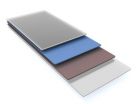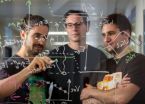(Press-News.org) This news release is available in German.
Extremely thin, semi-transparent, flexible solar cells could soon become reality. At the Vienna University of Technology, Thomas Mueller, Marco Furchi and Andreas Pospischil have managed to create a semiconductor structure consisting of two ultra-thin layers, which appears to be excellently suited for photovoltaic energy conversion
Several months ago, the team had already produced an ultra-thin layer of the photoactive crystal tungsten diselenide. Now, this semiconductor has successfully been combined with another layer made of molybdenum disulphide, creating a designer-material that may be used in future low-cost solar cells. With this advance, the researchers hope to establish a new kind of solar cell technology.
Two-Dimensional Structures
Ultra-thin materials, which consist only of one or a few atomic layers are currently a hot topic in materials science today. Research on two-dimensional materials started with graphene, a material made of a single layer of carbon atoms. Like other research groups all over the world, Thomas Mueller and his team acquired the necessary know-how to handle, analyse and improve ultra-thin layers by working with graphene. This know-how has now been applied to other ultra-thin materials.
"Quite often, two-dimensional crystals have electronic properties that are completely different from those of thicker layers of the same material", says Thomas Mueller. His team was the first to combine two different ultra-thin semiconductor layers and study their optoelectronic properties.
Two Layers with Different Functions
Tungsten diselenide is a semiconductor which consists of three atomic layers. One layer of tungsten is sandwiched between two layers of selenium atoms. "We had already been able to show that tungsten diselenide can be used to turn light into electric energy and vice versa", says Thomas Mueller. But a solar cell made only of tungsten diselenide would require countless tiny metal electrodes tightly spaced only a few micrometers apart. If the material is combined with molybdenium disulphide, which also consists of three atomic layers, this problem is elegantly circumvented. The heterostructure can now be used to build large-area solar cells.
When light shines on a photoactive material single electrons are removed from their original position. A positively charged hole remains, where the electron used to be. Both the electron and the hole can move freely in the material, but they only contribute to the electrical current when they are kept apart so that they cannot recombine.
To prevent recombination of electrons and holes, metallic electrodes can be used, through which the charge is sucked away - or a second material is added. "The holes move inside the tungsten diselenide layer, the electrons, on the other hand, migrate into the molybednium disulphide", says Thomas Mueller. Thus, recombination is suppressed.
This is only possible if the energies of the electrons in both layers are tuned exactly the right way. In the experiment, this can be done using electrostatic fields. Florian Libisch and Professor Joachim Burgdörfer (TU Vienna) provided computer simulations to calculate how the energy of the electrons changes in both materials and which voltage leads to an optimum yield of electrical power.
Tightly Packed Layers
"One of the greatest challenges was to stack the two materials, creating an atomically flat structure", says Thomas Mueller. "If there are any molecules between the two layers, so that there is no direct contact, the solar cell will not work." Eventually, this feat was accomplished by heating both layers in vacuum and stacking it in ambient atmosphere. Water between the two layers was removed by heating the layer structure once again.
Part of the incoming light passes right through the material. The rest is absorbed and converted into electric energy. The material could be used for glass fronts, letting most of the light in, but still creating electricity. As it only consists of a few atomic layers, it is extremely light weight (300 square meters weigh only one gram), and very flexible. Now the team is working on stacking more than two layers – this will reduce transparency, but increase the electrical power.
INFORMATION:
Further Information:
Prof. Thomas Mueller
Photonics Institute
TU Wien
Gusshausstraße 27-29, 1040 Vienna
T: +43-1-58801-38739
thomas.mueller@tuwien.ac.at
New material allows for ultra-thin solar cells
For the first time, 2 ultra-thin semiconductors have been stapled, creating a material with excellent optoelectronic properties
2014-08-04
ELSE PRESS RELEASES FROM THIS DATE:
New recommendations for post-treatment care of prostate cancer survivors
2014-08-04
New Rochelle, NY, August 4, 2014 -- Many of the more than 2.5 million men in the U.S. who have received treatment for prostate cancer deal with the often disabling side effects of surgery and radiation and hormonal therapies. To aid in the transition of these patients from specialty to primary care for long-term management of problems such as urinary incontinence and sexual and bowel dysfunction, updated guidelines for prostate cancer survivorship care are published in Journal of Men's Health, a peer-reviewed publication from Mary Ann Liebert, Inc., publishers. The article ...
Patient navigation may aid in breast cancer treatment in high-risk populations
2014-08-04
(Boston) -- Patient navigation, or the linking of a newly diagnosed cancer patient with a professional trained in assisting patients though the complex journey of cancer diagnosis and treatment, may lead to better breast cancer care in high risk and minority women. The findings, recently published in the Journal of Clinical Oncology, is the first national study to show a relationship between navigators and the initiation of certain recommended treatments in breast cancer.
Using data from a previously published, multi-center study funded by the National Cancer Institute, ...
Tricking plants to see the light may control the most important twitch on Earth
2014-08-04
MADISON, Wis. — Copious corn growing in tiny backyard plots? Roses blooming in December? Thanks to technology that the University of Wisconsin-Madison's Richard Vierstra has been developing for years, these things may soon be possible. And now, new findings out of the genetics professor's lab promise to advance that technology even further.
For the first time, Vierstra and his team have revealed the structure of the plant phytochrome, a critical molecule that detects the light that tells plants when to germinate, grow, make food, flower and even age. Like eyes, the phytochrome ...
Daylight is the best medicine, for nurses
2014-08-04
For the health and happiness of nurses – and for the best care of hospital patients – new Cornell research suggests exposure to natural light may be the best medicine.
In a forthcoming Cornell study published in the journal Health Environments Research and Design, Rana Zadeh, assistant professor of design and environmental analysis, discovered nurses who had access to natural light enjoyed significantly lower blood pressure, communicated more often with their colleagues, laughed more and served their patients in better moods than nurses who settled for large doses of ...
Diet change -- A solution to reduce water use?
2014-08-04
Eating less meat would protect water resources in dry areas around the world, researchers at Aalto University in Finland have found.
Reducing the use of animal products can have a considerable impact on areas suffering scarce water resources, as meat production requires more water than other agricultural products.
Diet change together with other actions, such as reduction of food losses and waste, may tackle the future challenges of food security, states researcher Mika Jalava from Aalto University in Finland.
Growing population and climate change are likely to ...
Cell plasticity may provide clues to origin of aggressive type of breast cancer
2014-08-04
INDIANAPOLIS -- Healthy breast cells may be able to reinvent themselves -- some have the flexibility to change after they are mature -- which leads researchers to postulate that similarities exist between this occurrence and the origins of a particularly aggressive type of breast cancer.
A team of researchers, led by Candice A.M. Sauder, M.D., while a resident at the Indiana University Department of Surgery, reported online in BMC Cell Biology that healthy breast cells separated from their normal environment were able to transform into types of cells similar to those ...
Students cope well with healthier snacks
2014-08-04
Students do not mind buying healthier snacks from vending machines, according to research published in the International Journal of Food Safety, Nutrition and Public Health. The findings could have implications for campus health initiatives as well as vendor profits.
The common stereotype of the busy student is of someone who will grab a junk food snack between lectures and rarely chooses a decent, hot meal over a chance to share a beer or two with fellow students. If the stereotype is an obvious generalization, one point remains true, snacks from vending machines on ...
Diabetes: A duo helps better
2014-08-04
Various active substances in oral antidiabetic agents are frequently combined in the treatment of diabetes in order to achieve an effective reduction in the blood sugar. A new, very promising approach combines the substances metformin and SGLT2 inhibitors, the latter were just approved in 2012. Scientists headed by Dr. Susanne Neschen and Prof. Dr. Martin Hrabě de Angelis from the Helmholtz Zentrum München, in cooperation with Ludwig-Maximilians-Universität München and drug manufacturer Sanofi Aventis, have discovered how the two substances reinforce each other.
Medicinal ...
Drilling in the dark: Biological impacts of fracking still largely unknown
2014-08-04
MADISON, Wis. – As production of shale gas soars, the industry's effects on nature and wildlife remain largely unexplored, according to a study by a group of conservation biologists published in Frontiers in Ecology and the Environment on August 1.
The report emphasizes the need to determine the environmental impact of chemical contamination from spills, well-casing failure, and other accidents.
"We know very little about how shale gas production is affecting plants and wildlife," says author Sara Souther, a conservation fellow in the Department of Botany at the ...
New insights into why adolescents carry meningitis-causing bacteria
2014-08-04
University of York scientists have shed new light on why teenagers and young adults are particularly susceptible to meningitis and septicaemia.
The team from the University's Department of Biology has discovered a novel metabolic pathway in the bacterium Neisseria meningitidis that may explain why this age group is particularly at risk of infection.
The results of the research, which was supported by the Centre for Chronic Diseases and Disorders (C2D2), are reported in the journal Molecular Microbiology.
N. meningitidis is a major cause of meningitis and septicaemia, ...
LAST 30 PRESS RELEASES:
Chicago health information leader recognized for raising CPR readiness and blood pressure awareness
The Intimate Animal, a new book from Kinsey Institute Executive Director Dr. Justin Garcia
When blue-collar workers lose union protection, they try self-employment
New video dataset to advance AI for health care
MEA-based graph deviation network for early autism syndrome signatures in human forebrain organoids
New modeling approach sheds light on rare gut disease
Study documents potentially hazardous flame retardants in firefighter gear
Can certain bacteria regulate aging of the immune system and its related alterations?
AI model helps diagnose often undetected heart disease from simple EKG
There are fewer online trolls than people think
Cell membrane fluctuations produce electricity
Jeonbuk National University study shows positive parenting can protect adolescents against self-harm
Surface-engineered ZnO nanocrystals to tackle perfluoroalkyl substance contamination
This new understanding of T cell receptors may improve cancer immunotherapies
A new fossil face sheds light on early migrations of ancient human ancestor
A new immunotherapy approach could work for many types of cancer
A new way to diagnose deadly lung infections and save lives
40 percent of MRI signals do not correspond to actual brain activity
How brain-inspired algorithms could drive down AI energy costs
Gum disease may be linked to plaque buildup in arteries, higher risk of major CVD events
Contrails are a major driver of aviation’s climate impact
Structure of dopamine-releasing neurons relates to the type of circuits they form for smell-processing
Reducing social isolation protects the brain in later life
Keeping the heart healthy increases longevity even after cancer
Young adults commonly mix cannabis with nicotine and tobacco
Comprehensive review illuminates tau protein's dual nature in brain health, disease, and emerging psychiatric connections
Book prepares K-12 leaders for the next public health crisis
Storms in the Southern Ocean mitigates global warming
Seals on the move: Research reveals key data for offshore development and international ecology
Sports injuries sustained during your period might be more severe
[Press-News.org] New material allows for ultra-thin solar cellsFor the first time, 2 ultra-thin semiconductors have been stapled, creating a material with excellent optoelectronic properties



